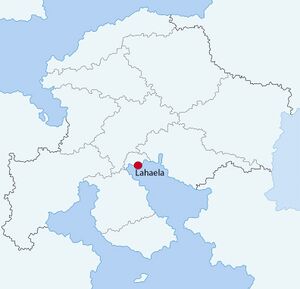Lo Lanno
This article is incomplete because it is pending further input from participants, or it is a work-in-progress by one author. Please comment on this article's talk page to share your input, comments and questions. Note: To contribute to this article, you may need to seek help from the author(s) of this page. |
Lahaela
라해라 | |
|---|---|
Capital City | |
Image of downtown Lahaela and Lahaela Palace | |
| Nickname: Hael/Haela | |
Lahaela, marked on a map of The Cape Bay | |
| Country | The Cape Bay |
| Territory | Lahaela Metro |
| First Established | ~3,000BCE |
| Founded by | Unknown |
| Capital | Bajing |
| Government | |
| • Body | Council of Lahaela |
| • Mayor | Tara Chal-Seng-Hweon (Green - Urban) |
| Area | |
| • Capital City | 6,123 km2 (2,364 sq mi) |
| • Urban | 2,342 km2 (904 sq mi) |
| • Rural | 3,781 km2 (1,460 sq mi) |
| • Metro | 6,123 km2 (2,364 sq mi) |
| Elevation | 9 m (30 ft) |
| Population (2022) | |
| • Capital City | 29,837,815 |
| • Density | 4,900/km2 (13,000/sq mi) |
| Demonym | Lahaelan |
| Time zone | -2 |
| City Code | 1L-1H-1L |
| Website | www |
Lahaela is the biggest and most important city in The Cape Bay. It is the capital of the nation as well as where tourists and immigrants flock to to enjoy the hot summers, beautiful cityscape and stunning beaches and nature. The city is also one of the skyscraper capitals of the world with over 170 completed buildings, however it is still second to Port Adela just in The Cape Bay, which has over 300. Lahaela is the seat of government as well as home to the main palace of the Cape Royal Family, Lahaela palace.
History
Ancient History
Lahaela was first founded around the year 3,000BCE by local tribes and due to its strategic position helped the tribe expand into the Salkik Empire which conquered much of the southern coast of the modern Cape Bay. The city quickly grew and the first palace was built only a hundred or so years after the foundation, it is even thought that Lahaela meant 'palace' or 'seat of government' in ancient Aljian. The city had strong control over the empire and managed to sustain itself on agriculture selling things like fruits, spices and and becoming a trading hub for the Empire. Eventually when it was time to give the empire subdivisions, Lahaela was given its own jurisdiction to expand with the city, this also let people in the city be governed by different laws, giving them more rights than the outlying peasants, which began mass immigration from the country sides to the city. When the Salkik empire collapsed in 982AD the Chushga Empire took hold of the city and expanded it down to the island of Al Siyara and up to Rie Lake, keeping Lahaela the capital of the growing empire.
Early Colonial Times
In 1550 the southern island of Al Siyara was officially colonised by the Riamese Empire, giving them a strategic point to launch an invasion of the southern peninsula, belonging to the Chushga Empire. An invasion was launched in 1599 and the Riamese took full control of the lands and Lahaela by 1652AD. Lahaela was set as the new capital for the colony, seemingly due to its size and defensive position. They called their new colony 'The Royal Cape Lahaela stayed an important point, likely the most important point in throughout colonial history in The Cap Bay, not only due to its size and position as a geographical centre, but also as it became a meeting point for locals to interact with their government and empire at a larger scale. However, in 1794 growing discontent with inequality and a non-representative government led to the people of the city throwing out the royal family, whom fled to the Northern Saho Islands. At this time anti-riamese sentiments also grew leading to locals burning down and destroying riamese neighbourhoods, the riamese retaliated by burning down many historical districts of the city which only caused more tensions. In the following year a mass revolution took place in the eastern colony as the provinces declared independence from the Riamese Empire. Half of the city seceded into The Free Territory of Deljuna, while the other half stayed in the Riamese Empire. The split took place along the Kajasimi river which flowed through the city, and it stood as the official mark of separation for the remainder of the time the colony was split. both sides took part in tearing down large swaths of buildings and replacing them with ones that fit with the dominating culture, giving the city two very different looking sides. The Free Territory of Deljuna only last another 71 years before collapsing in 1865 due to food shortages, where it then fell back into the hands of the Riamese Empire. The east controlled side of the city came out significantly poorer than the west due to the mismanagement of resources which made the territory extremely poor, to this day there remains a large class divide and wealth disparity between the poorer east and a richer west of the city.

